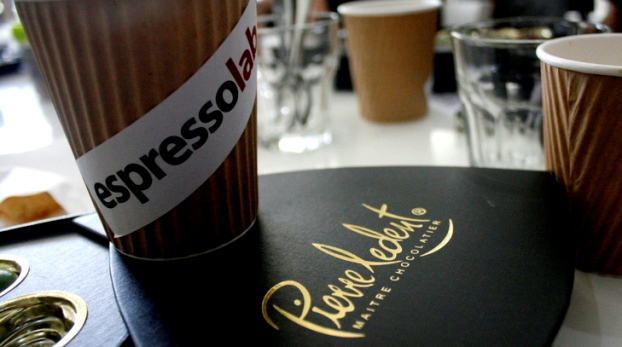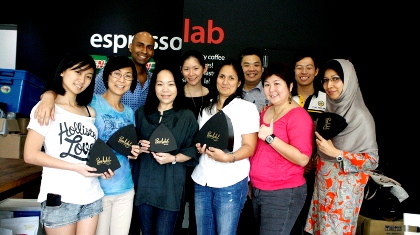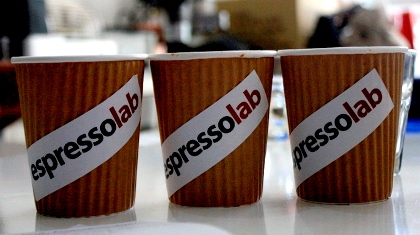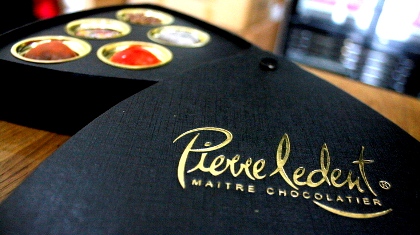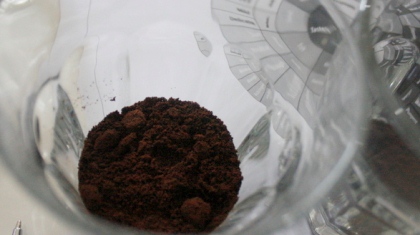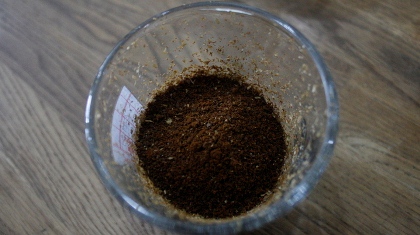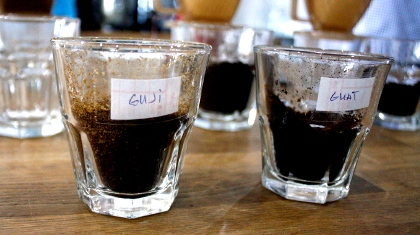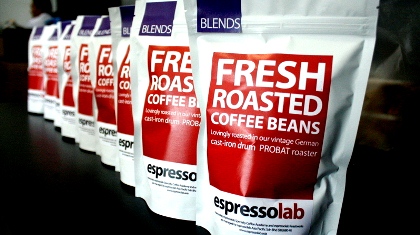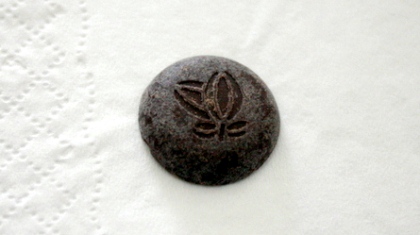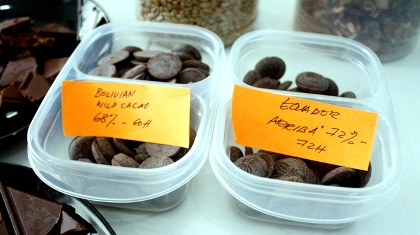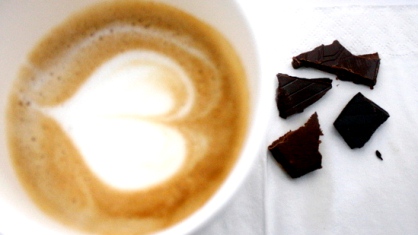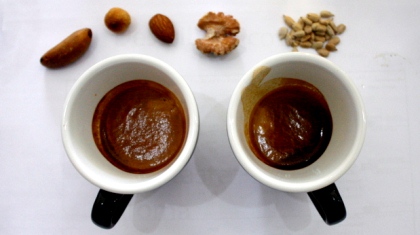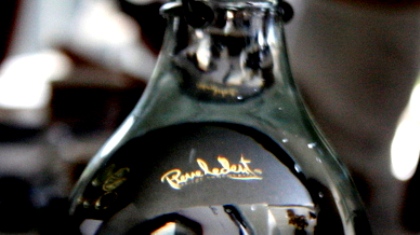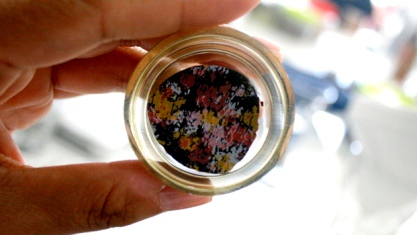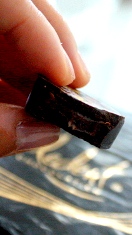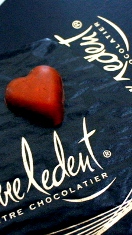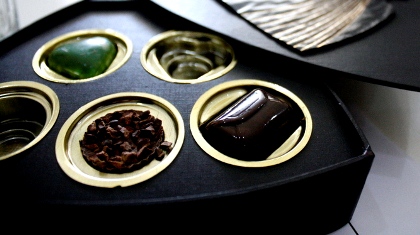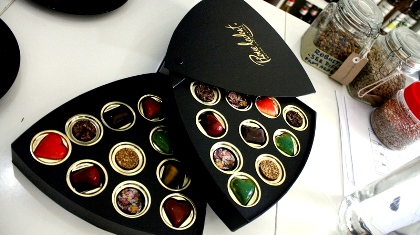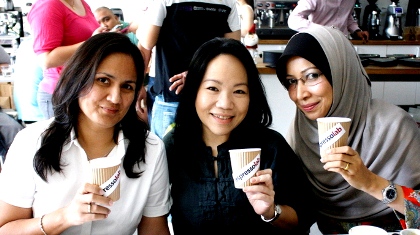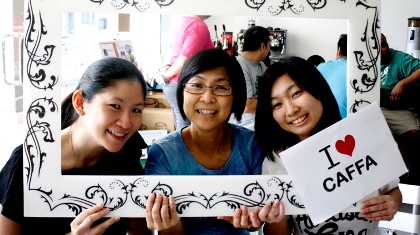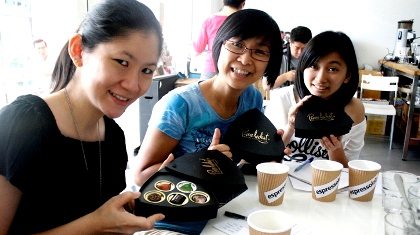An event organised by Kaffa
Coffee: Single origin coffee from Guatemala, Indonesia and Ethiopia
Venue: Espressolab
Chocolate: Pierre Ledent (Belgium)
Date: 2 February 2013
Time: 10am
This event brought together the pairing of coffee and cocoa, both grown in the same climate for the indulgence of coffee and chocolate lovers.
Leong Hoo Yin from espressolab and Indra Seghar from Pierre Ledent were the speakers for the workshop.
The audience was introduced first to the coffee to be used for the tasting. Leong has chosen coffee beans from three distinctive regions: Guatemala, Indonesia and Ethiopia as the taste profile for these beans can be distinguished easily.
.jpg)
Part of the "cupping" process is to slurp a spoonfull of coffee to nose and taste the liquid
Tasting depends more on the nose than the tongue, therefore the workshop started off with sniffing ground coffee from the three regions and a tasting chart used to determine different smells and tastes was provided by Leong as a reference.
There are 5 different ways of describing the taste of the coffee, in sequence: acidity, body, aftertaste, aroma and flavor. With that in mind, we were given a cupping sheet to record our tasting notes. We find the following:
Coffee ground from Guatemala beans
Coffee ground from Indonesian Guji beans
The difference in colour and body the the two origins
Indonesia: Strong bitterness on the palate, taste of herbally and spiciness aftertaste. It is the type of coffee taste we are familiar with in this region.
Guatemala: Sweet on the palate with very slight nutty taste and smooth finish. The easiest drinking coffee.
Ethiopia: Floral notes, fruity taste and with the highest acidity of all three. The acidity hits the palate first leaving very little after taste.
Coffee beans from Guatemala cover the biggest supply around the world compared to Indonesia and Ethiopia based on a very important reason: political stableness. The lack of war and movements has helped the growth of the coffee beans as well as its supply. The widely acceptable taste profile plays as big a role for its popularity.
espressolab's house blend
Asian taste profile
For the Asian coffee drinker however, we are probably more receptive towards the Indonesian flavor profile as we grow up drinking more Robusta coffee, which is thick, dark and more acidic. We gradually move towards Ethiopian coffee but would tend to be adjusted to Guatemala brans first for its neutral profile. One of the explanation would be obvious as most of the instant coffee available in our market uses Guatemala beans.
Can we tell what are the tastes?
“One of the obstacles in the local coffee drinking scene is that we lack the experience in expressing taste profile. Unlike the western culture, which are more open to describing their feelings, the Asian culture are told to speak less during our meals and that has kept us away from expressing ourselves about our palate.” explained Leong. We are of the view that Asian food is not usually used to describe taste profile. It would take time to have to replace similar expression to food such as butter, berries, vanilla, candy, nutty, chocolaty etc with their Asian equivalents.
The blend
After explaining the facts and taste profile of the three beans, we were introduced to blended coffee and were given the opportunity to mix the three coffee to try out which one suits our palate best. We find blending Guji and Mandala beans tasted best as the acidity as balanced by the strong herbally bitterness.
Current trend
We are getting many coffee drinkers preferring Ethiopian acidity at the moment and some even go to the extend to express the higher the acidity the better the bean quality is. Which Leong feels very much depends on individual palate. However, it is a misconception to think that only acidity determines the quality of the beans. Leong advised consumers to ask for the flavor of the beans instead of region to find which taste suits our palate best as that would be a more accurate approach in finding which type of coffee we actually like.
Pairings
We were given different types of chocolate to taste with a cappuccino:
a) Chocolate 68% Bolivia wild cocoa (described as the best chocolate in the world) - Sweet, milky and smooth with cappuccino. It brings out the fattiness in the chocolate that compliments the milk in the coffee.
b) Ecuador Arriba 72% - The bitterness in the chocolate cut through the acidity and creaminess in the cappuccino that brought out the slight saltiness in the cocoa.
c) Chocolate with sea salt – The salt makes the milk smell stronger especially with milk chocolate; with darker chocolate however, a bit more bitter.
d) Chocolate with macadamia nuts – The nuts make the cappuccino tastes smoother ad creamier on the tongue. No change on the acidity of the coffee.
We were given espresso to taste with nuts:
The writer had too much trouble palating the high acidity in the espresso, and was a little too tipsy on caffeine. Therefore, this pairing was inconclusive.
Pierre Ledent
An introduction of the brand was given by the Marketing Director, Indra Segher. More details about the brand, please refer to their website.
Pamela – This piece that is made of 70% cocoa from Venezuela contains praline that created a nice surprise while biting into it. With the second bite and a sip of coffee, it gives the chocolate a clean finish and the slight acidity in the Guatemala coffee used brought out the scent of cocoa on the nose.
It is said that the filling in each Pierre Ledent Chocolate that gives the surprise in every bite
Iris – Made with pure rose water from France. A new recipe made for the Asian palate. Paired with coffee that strengthen its rose scent. It is also suggested to have it with champagne or white wine to bring out its distinct rose on the nose.
Rosa (left) and Amadou (right); Ballotine (top)
Rosa – A praline with orange peel and hazelnut bits. Its citrusy like flavor was taken over by the acidity of the coffee. It was suggested that this piece would go best with Chinese tea such as Pu Er.
Amadou – A praline with almond and nuts. Compliment the coffee just like a cookie, smokey and nutty with a smooth finish.
Ballotine – This is a special one that is a spicy praline. The taste of spice only comes out a few seconds after it melts and it appears at the back of the throat. Coffee with milk can wash down the spiciness, without milk however, makes the spiciness more apparent.
A box of 5 pieces shown during the workshop is called Quinta and it is sold at RM79.90 at Jason’s Food Market at Bangsar Shopping Centre. Keep the box and store your jewelry.
There are one, two and three level sliding designs available for all their selections of Solo, Trio, Quinta, Deca and Royal. The double level sliding design is best for Valentine’s day.
Other photos:
.jpg)
